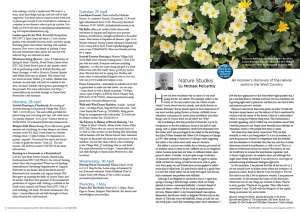
Have you ever wondered why so many of our early spring flowers are yellow? For example, yellow is the colour of the very earliest one, the winter aconite which I wrote about here last month, and which flowers in January-February. But in March-April we have three more of our most notable spring flowers in bloom, daffodils, lesser celandines and primroses (never mind dandelions and other things) and of course these are all yellow too. Why?
My own feeling is that they probably evolved this way to be conspicuous to the few pollinators about in the chill of early spring, such as queen bumblebees, which have hibernated over the winter; and I am encouraged in this belief by the knowledge that John D Herz founded the Yellow Cab Company in Chicago in 1907 after reading a University of Chicago study suggesting that yellow is the colour most easily seen at a distance.
But yellow is not just very visible; for us humans, possessed of an aesthetic sense, it seems to me a difficult not to say dangerous colour, because more than any other, its different shades seem prone to excess. Consider: we have quite a large vocabulary of perjorative adjectives in English which we apply to colours which we find too strong or bold for our taste, such as garish, lurid, brash, gaudy, etc, and I think these can be applied to yellow more than to other hues. It’s quite hard to think of a garish blue, is it not? But a lurid yellow can be easily envisaged. And for me, that’s sometimes the problem with daffodils.
Although I am delighted to see the first one as a signal that spring is coming, I find the large varieties which are widely planted in towns—‘municipal daffodils’, a botanist friend of mine calls them—often to be too brash in appearance for my taste. ‘Bilious yellow’ is my botanical friend’s description. Remember, the blooms which so delighted Wordsworth on the shores of Ullswater were wild daffodils, which are half the size and much paler. And I feel something similar about celandines. I love the first appearance of that bold yellow eight-pointed star, I get a real kick from it, but here in Dorset you can sometimes see it growing right next to primroses and then you see what it lacks, and primroses possess: restraint.
Primroses aren’t loud: their outer petals are what I would call the palest creamy lemon, and the delicacy of that is reinforced by contrast with the centre of the flower, a blob of a richer yellow which is strong but without being brash. The combination is instantly appealing, and if I follow my own aesthetic sense I find I feel that primroses are simply more beautiful than daffodils or celandines, which is why people love them so much.
Yet where does their beauty come from? Why are they beautiful, as well as just being yellow? Is it just an accident, or have the primroses evolved in competition with the daffodils and the celandines to be lovelier than they are, and thus to make them more attractive to pollinators, as well as to us? That is, is there an evolutionary reason for beauty? For there to be one, we would have to assume that non-human organisms such as insects might possess an aesthetic sense; and although that might seem wholly far-fetched, I can tell you it is a hot topic of research among evolutionary biologists right now.
In the meantime, I am pleased that like all the rest of us, I do not actually have to bother about where the loveliness of primroses comes from; in Dorset I can just enjoy it. For the first time in my life, I live in primrose country. I am primrose-surrounded. At the moment the banks of the three lanes which lead out of our village are covered in them. They’re in every garden. They’re in our garden. They offer beauty everywhere I turn. To hell with the fleshpots of the capital. Being an incomer was never better.




